Analyzing Training's Impact on Employee Performance at Sainsbury
VerifiedAdded on 2020/10/22
|11
|2795
|104
Report
AI Summary
This report investigates the impact of training and development programs on employee performance at Sainsbury, Malta. The research begins with an introduction to the importance of training and development, followed by the aim and objectives of the study, which include analyzing the concept of training, the influence of training programs, and the relationship between training and employee performance. The report outlines the research methodology, including the use of interpretivism and positivism philosophies, explanatory and descriptive research approaches, and a mixed-methods strategy incorporating both qualitative and quantitative data collection. The research design utilizes a descriptive approach, and data is collected from both primary and secondary sources, with a non-probabilistic sampling method involving 30 employees. Data analysis will be conducted using thematic analysis. Ethical considerations are also addressed. The report aims to provide insights into the effectiveness of training programs in enhancing employee skills and knowledge, ultimately contributing to improved performance within the organization.
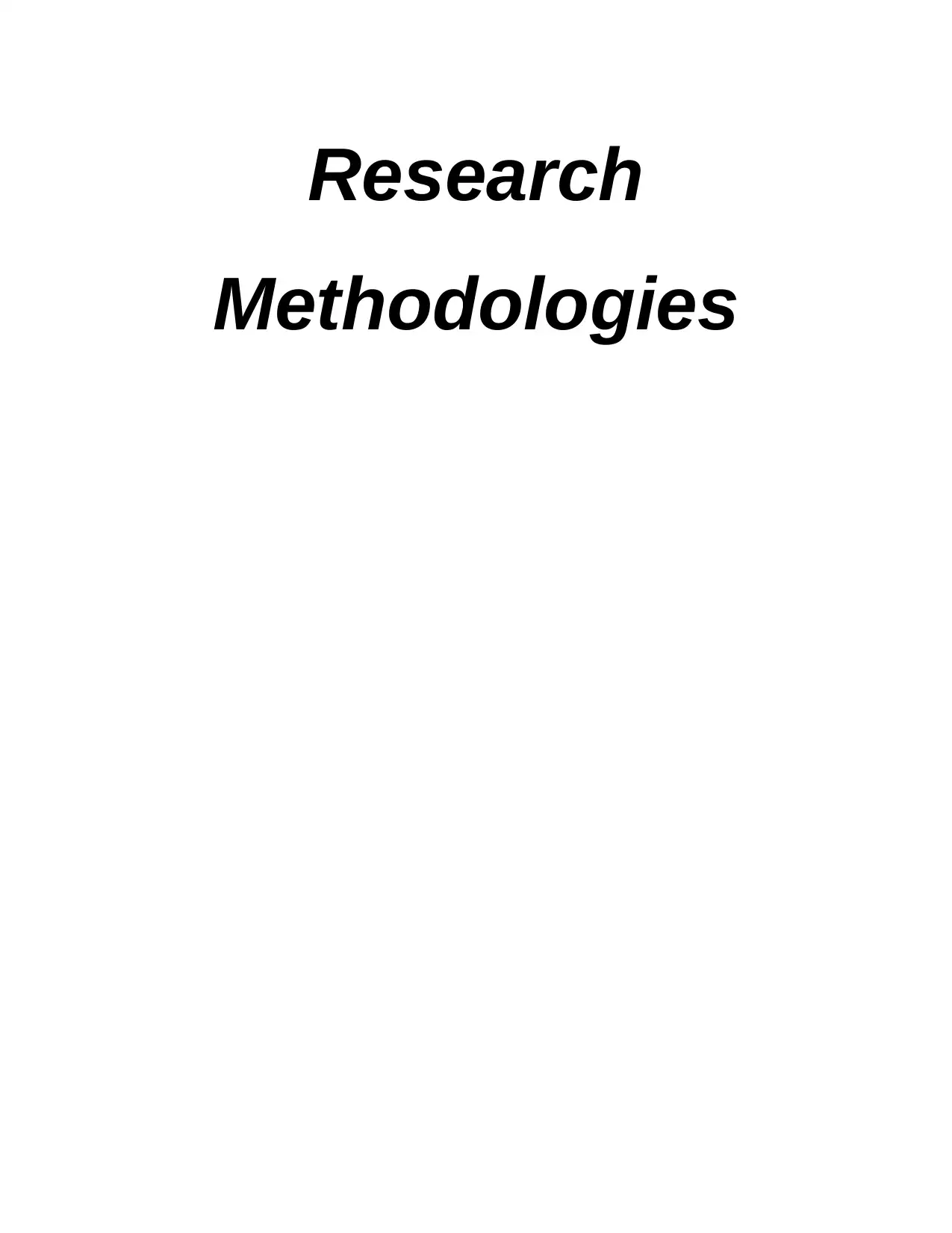
Research
Methodologies
Methodologies
Paraphrase This Document
Need a fresh take? Get an instant paraphrase of this document with our AI Paraphraser
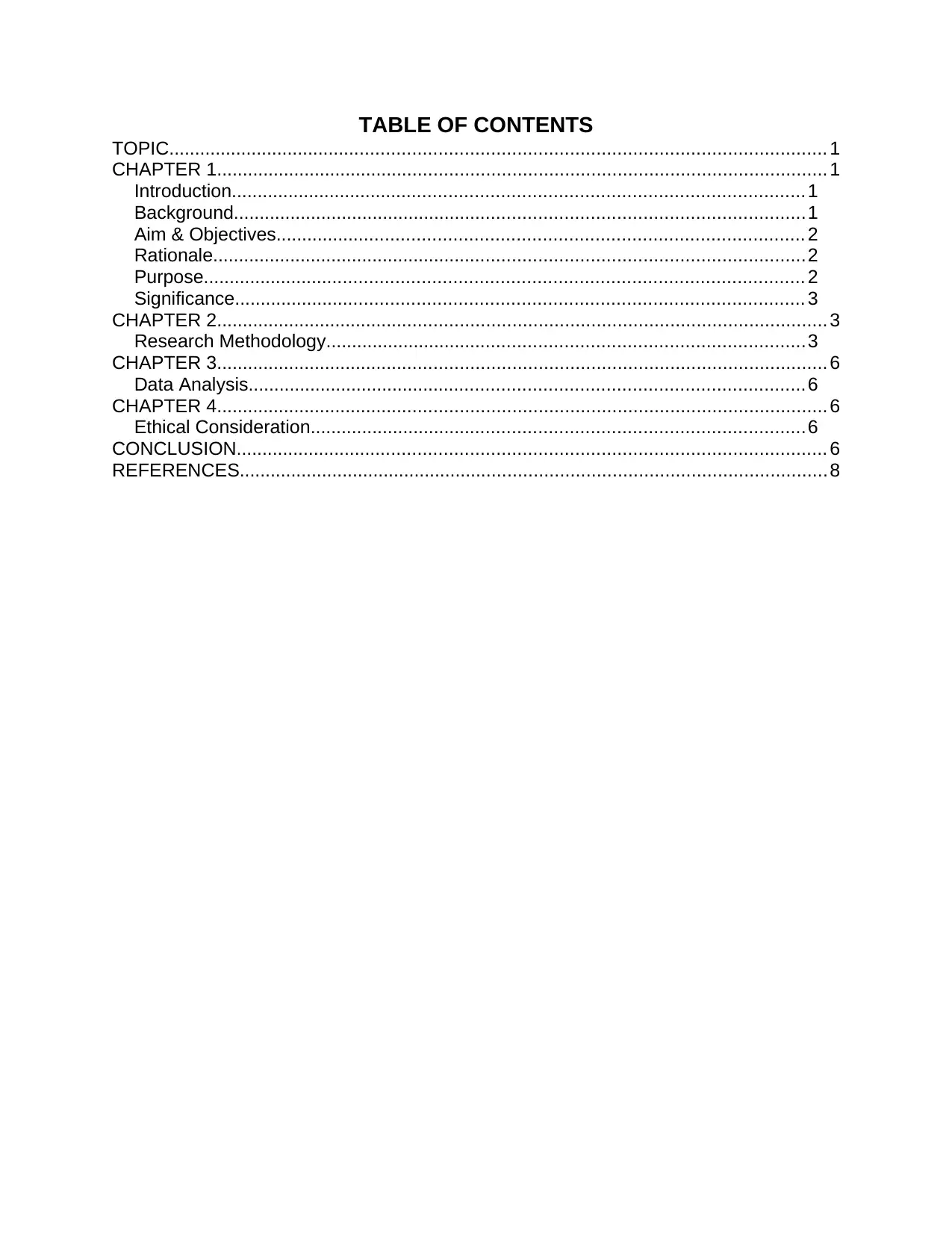
TABLE OF CONTENTS
TOPIC.............................................................................................................................. 1
CHAPTER 1..................................................................................................................... 1
Introduction.............................................................................................................. 1
Background..............................................................................................................1
Aim & Objectives..................................................................................................... 2
Rationale..................................................................................................................2
Purpose................................................................................................................... 2
Significance............................................................................................................. 3
CHAPTER 2..................................................................................................................... 3
Research Methodology............................................................................................3
CHAPTER 3..................................................................................................................... 6
Data Analysis...........................................................................................................6
CHAPTER 4..................................................................................................................... 6
Ethical Consideration...............................................................................................6
CONCLUSION................................................................................................................. 6
REFERENCES.................................................................................................................8
TOPIC.............................................................................................................................. 1
CHAPTER 1..................................................................................................................... 1
Introduction.............................................................................................................. 1
Background..............................................................................................................1
Aim & Objectives..................................................................................................... 2
Rationale..................................................................................................................2
Purpose................................................................................................................... 2
Significance............................................................................................................. 3
CHAPTER 2..................................................................................................................... 3
Research Methodology............................................................................................3
CHAPTER 3..................................................................................................................... 6
Data Analysis...........................................................................................................6
CHAPTER 4..................................................................................................................... 6
Ethical Consideration...............................................................................................6
CONCLUSION................................................................................................................. 6
REFERENCES.................................................................................................................8
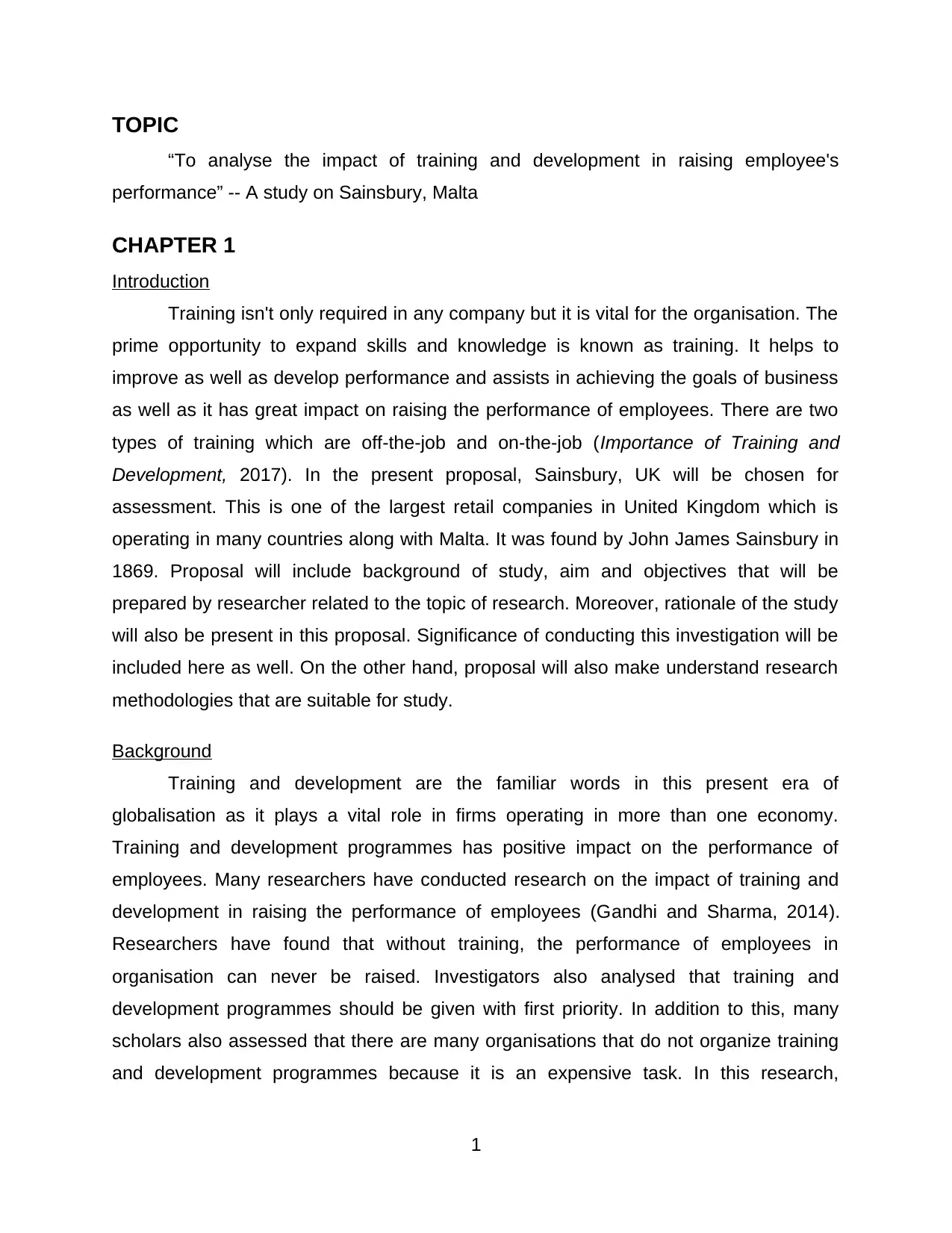
TOPIC
“To analyse the impact of training and development in raising employee's
performance” -- A study on Sainsbury, Malta
CHAPTER 1
Introduction
Training isn't only required in any company but it is vital for the organisation. The
prime opportunity to expand skills and knowledge is known as training. It helps to
improve as well as develop performance and assists in achieving the goals of business
as well as it has great impact on raising the performance of employees. There are two
types of training which are off-the-job and on-the-job (Importance of Training and
Development, 2017). In the present proposal, Sainsbury, UK will be chosen for
assessment. This is one of the largest retail companies in United Kingdom which is
operating in many countries along with Malta. It was found by John James Sainsbury in
1869. Proposal will include background of study, aim and objectives that will be
prepared by researcher related to the topic of research. Moreover, rationale of the study
will also be present in this proposal. Significance of conducting this investigation will be
included here as well. On the other hand, proposal will also make understand research
methodologies that are suitable for study.
Background
Training and development are the familiar words in this present era of
globalisation as it plays a vital role in firms operating in more than one economy.
Training and development programmes has positive impact on the performance of
employees. Many researchers have conducted research on the impact of training and
development in raising the performance of employees (Gandhi and Sharma, 2014).
Researchers have found that without training, the performance of employees in
organisation can never be raised. Investigators also analysed that training and
development programmes should be given with first priority. In addition to this, many
scholars also assessed that there are many organisations that do not organize training
and development programmes because it is an expensive task. In this research,
1
“To analyse the impact of training and development in raising employee's
performance” -- A study on Sainsbury, Malta
CHAPTER 1
Introduction
Training isn't only required in any company but it is vital for the organisation. The
prime opportunity to expand skills and knowledge is known as training. It helps to
improve as well as develop performance and assists in achieving the goals of business
as well as it has great impact on raising the performance of employees. There are two
types of training which are off-the-job and on-the-job (Importance of Training and
Development, 2017). In the present proposal, Sainsbury, UK will be chosen for
assessment. This is one of the largest retail companies in United Kingdom which is
operating in many countries along with Malta. It was found by John James Sainsbury in
1869. Proposal will include background of study, aim and objectives that will be
prepared by researcher related to the topic of research. Moreover, rationale of the study
will also be present in this proposal. Significance of conducting this investigation will be
included here as well. On the other hand, proposal will also make understand research
methodologies that are suitable for study.
Background
Training and development are the familiar words in this present era of
globalisation as it plays a vital role in firms operating in more than one economy.
Training and development programmes has positive impact on the performance of
employees. Many researchers have conducted research on the impact of training and
development in raising the performance of employees (Gandhi and Sharma, 2014).
Researchers have found that without training, the performance of employees in
organisation can never be raised. Investigators also analysed that training and
development programmes should be given with first priority. In addition to this, many
scholars also assessed that there are many organisations that do not organize training
and development programmes because it is an expensive task. In this research,
1
⊘ This is a preview!⊘
Do you want full access?
Subscribe today to unlock all pages.

Trusted by 1+ million students worldwide
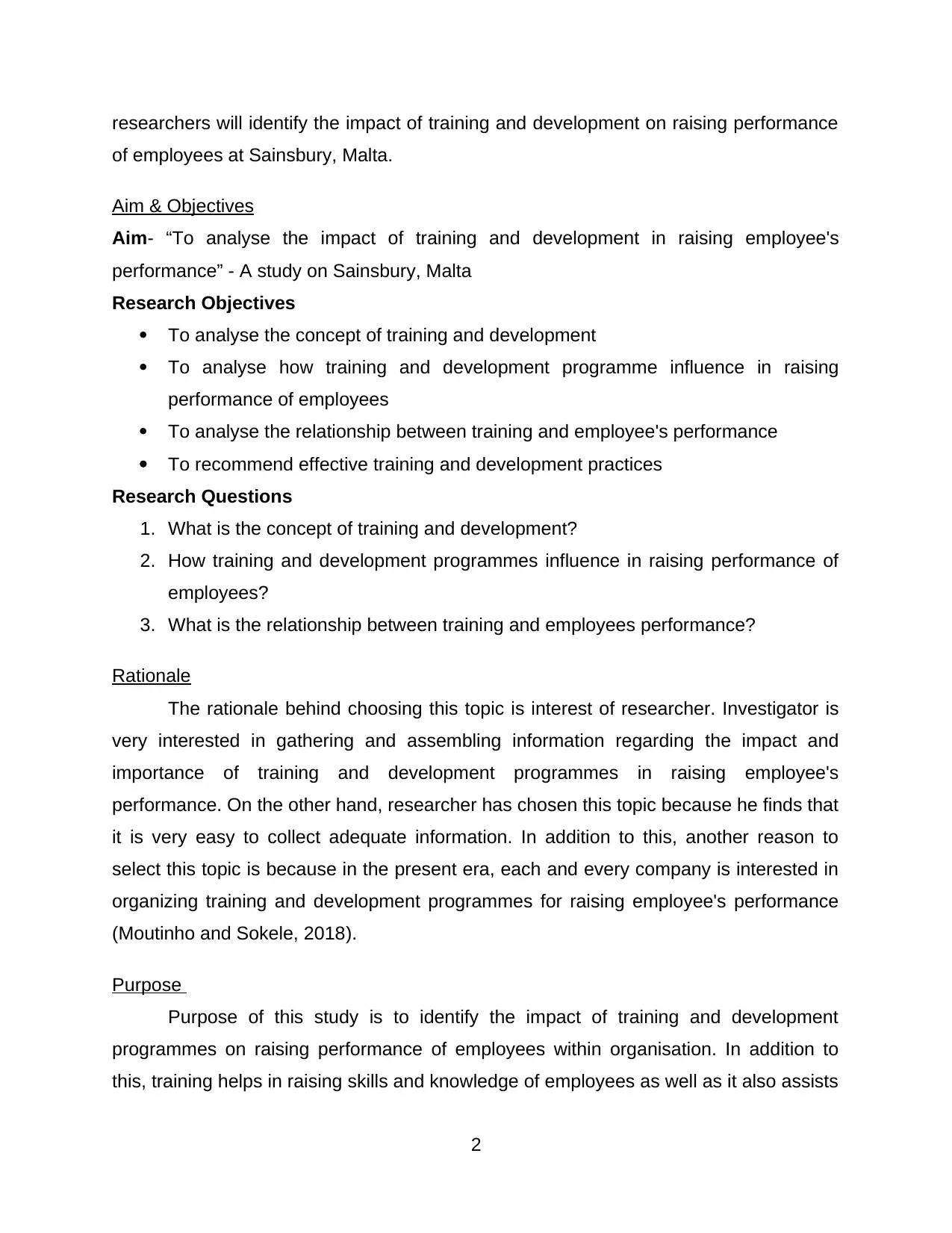
researchers will identify the impact of training and development on raising performance
of employees at Sainsbury, Malta.
Aim & Objectives
Aim- “To analyse the impact of training and development in raising employee's
performance” - A study on Sainsbury, Malta
Research Objectives
To analyse the concept of training and development
To analyse how training and development programme influence in raising
performance of employees
To analyse the relationship between training and employee's performance
To recommend effective training and development practices
Research Questions
1. What is the concept of training and development?
2. How training and development programmes influence in raising performance of
employees?
3. What is the relationship between training and employees performance?
Rationale
The rationale behind choosing this topic is interest of researcher. Investigator is
very interested in gathering and assembling information regarding the impact and
importance of training and development programmes in raising employee's
performance. On the other hand, researcher has chosen this topic because he finds that
it is very easy to collect adequate information. In addition to this, another reason to
select this topic is because in the present era, each and every company is interested in
organizing training and development programmes for raising employee's performance
(Moutinho and Sokele, 2018).
Purpose
Purpose of this study is to identify the impact of training and development
programmes on raising performance of employees within organisation. In addition to
this, training helps in raising skills and knowledge of employees as well as it also assists
2
of employees at Sainsbury, Malta.
Aim & Objectives
Aim- “To analyse the impact of training and development in raising employee's
performance” - A study on Sainsbury, Malta
Research Objectives
To analyse the concept of training and development
To analyse how training and development programme influence in raising
performance of employees
To analyse the relationship between training and employee's performance
To recommend effective training and development practices
Research Questions
1. What is the concept of training and development?
2. How training and development programmes influence in raising performance of
employees?
3. What is the relationship between training and employees performance?
Rationale
The rationale behind choosing this topic is interest of researcher. Investigator is
very interested in gathering and assembling information regarding the impact and
importance of training and development programmes in raising employee's
performance. On the other hand, researcher has chosen this topic because he finds that
it is very easy to collect adequate information. In addition to this, another reason to
select this topic is because in the present era, each and every company is interested in
organizing training and development programmes for raising employee's performance
(Moutinho and Sokele, 2018).
Purpose
Purpose of this study is to identify the impact of training and development
programmes on raising performance of employees within organisation. In addition to
this, training helps in raising skills and knowledge of employees as well as it also assists
2
Paraphrase This Document
Need a fresh take? Get an instant paraphrase of this document with our AI Paraphraser
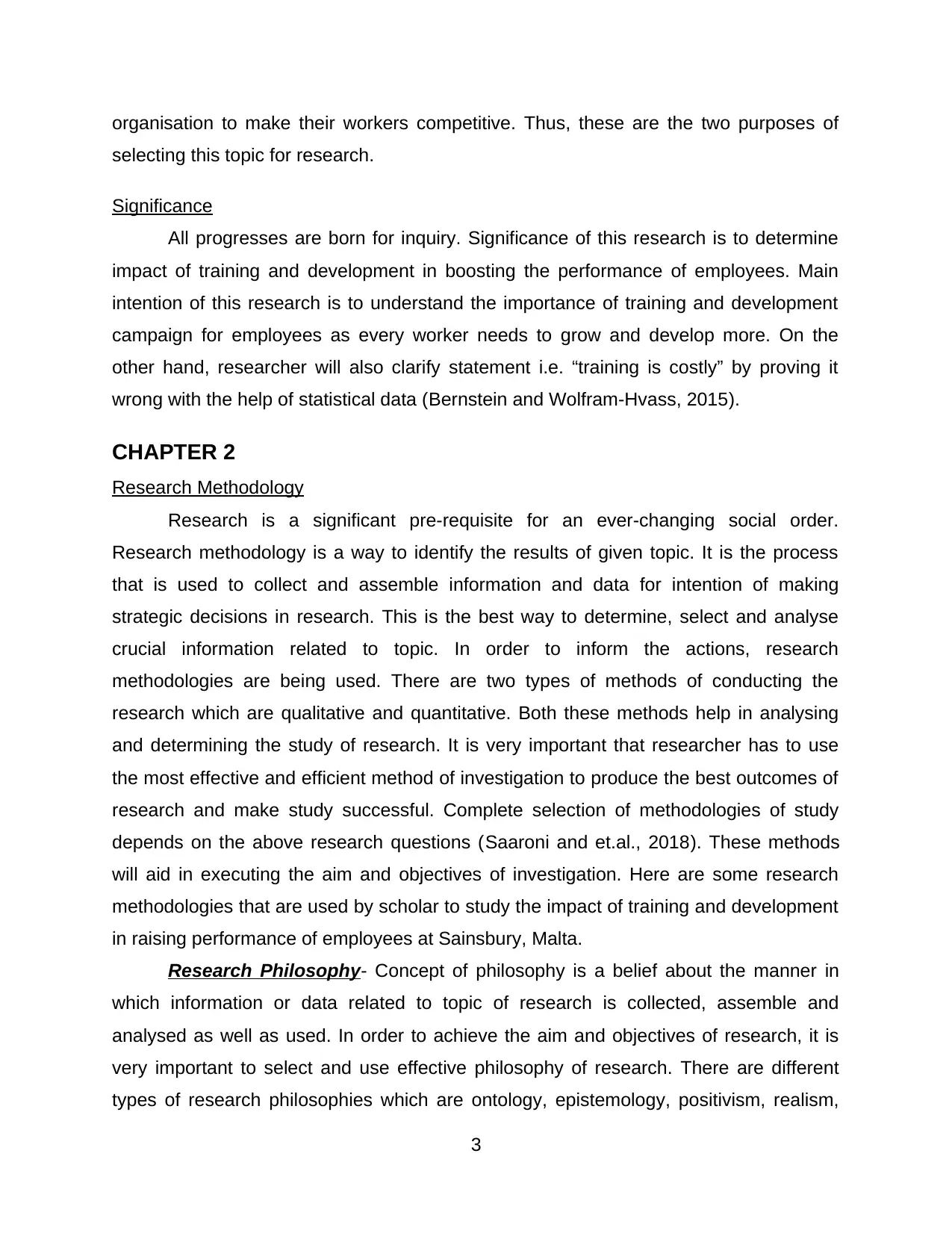
organisation to make their workers competitive. Thus, these are the two purposes of
selecting this topic for research.
Significance
All progresses are born for inquiry. Significance of this research is to determine
impact of training and development in boosting the performance of employees. Main
intention of this research is to understand the importance of training and development
campaign for employees as every worker needs to grow and develop more. On the
other hand, researcher will also clarify statement i.e. “training is costly” by proving it
wrong with the help of statistical data (Bernstein and Wolfram-Hvass, 2015).
CHAPTER 2
Research Methodology
Research is a significant pre-requisite for an ever-changing social order.
Research methodology is a way to identify the results of given topic. It is the process
that is used to collect and assemble information and data for intention of making
strategic decisions in research. This is the best way to determine, select and analyse
crucial information related to topic. In order to inform the actions, research
methodologies are being used. There are two types of methods of conducting the
research which are qualitative and quantitative. Both these methods help in analysing
and determining the study of research. It is very important that researcher has to use
the most effective and efficient method of investigation to produce the best outcomes of
research and make study successful. Complete selection of methodologies of study
depends on the above research questions (Saaroni and et.al., 2018). These methods
will aid in executing the aim and objectives of investigation. Here are some research
methodologies that are used by scholar to study the impact of training and development
in raising performance of employees at Sainsbury, Malta.
Research Philosophy- Concept of philosophy is a belief about the manner in
which information or data related to topic of research is collected, assemble and
analysed as well as used. In order to achieve the aim and objectives of research, it is
very important to select and use effective philosophy of research. There are different
types of research philosophies which are ontology, epistemology, positivism, realism,
3
selecting this topic for research.
Significance
All progresses are born for inquiry. Significance of this research is to determine
impact of training and development in boosting the performance of employees. Main
intention of this research is to understand the importance of training and development
campaign for employees as every worker needs to grow and develop more. On the
other hand, researcher will also clarify statement i.e. “training is costly” by proving it
wrong with the help of statistical data (Bernstein and Wolfram-Hvass, 2015).
CHAPTER 2
Research Methodology
Research is a significant pre-requisite for an ever-changing social order.
Research methodology is a way to identify the results of given topic. It is the process
that is used to collect and assemble information and data for intention of making
strategic decisions in research. This is the best way to determine, select and analyse
crucial information related to topic. In order to inform the actions, research
methodologies are being used. There are two types of methods of conducting the
research which are qualitative and quantitative. Both these methods help in analysing
and determining the study of research. It is very important that researcher has to use
the most effective and efficient method of investigation to produce the best outcomes of
research and make study successful. Complete selection of methodologies of study
depends on the above research questions (Saaroni and et.al., 2018). These methods
will aid in executing the aim and objectives of investigation. Here are some research
methodologies that are used by scholar to study the impact of training and development
in raising performance of employees at Sainsbury, Malta.
Research Philosophy- Concept of philosophy is a belief about the manner in
which information or data related to topic of research is collected, assemble and
analysed as well as used. In order to achieve the aim and objectives of research, it is
very important to select and use effective philosophy of research. There are different
types of research philosophies which are ontology, epistemology, positivism, realism,
3
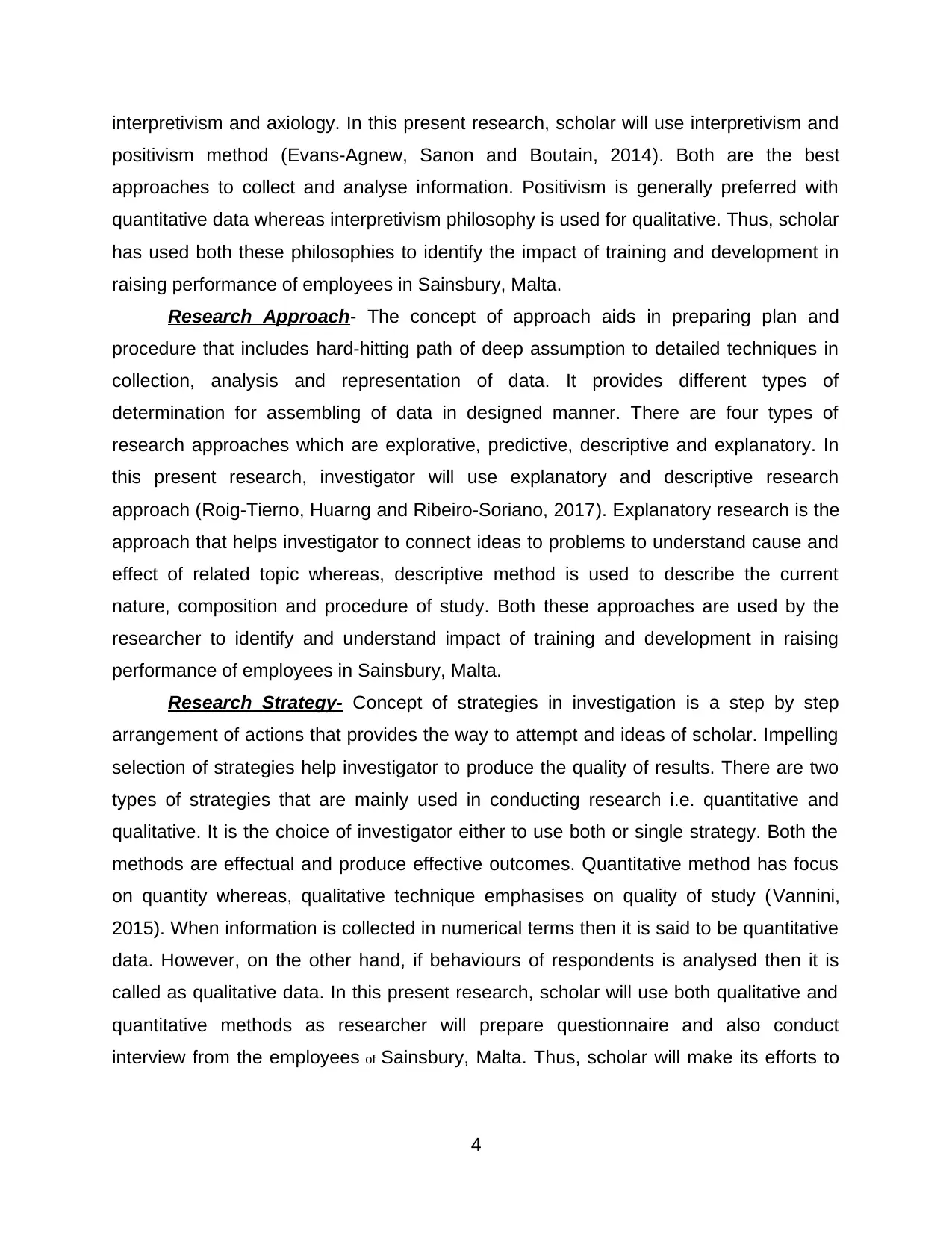
interpretivism and axiology. In this present research, scholar will use interpretivism and
positivism method (Evans-Agnew, Sanon and Boutain, 2014). Both are the best
approaches to collect and analyse information. Positivism is generally preferred with
quantitative data whereas interpretivism philosophy is used for qualitative. Thus, scholar
has used both these philosophies to identify the impact of training and development in
raising performance of employees in Sainsbury, Malta.
Research Approach- The concept of approach aids in preparing plan and
procedure that includes hard-hitting path of deep assumption to detailed techniques in
collection, analysis and representation of data. It provides different types of
determination for assembling of data in designed manner. There are four types of
research approaches which are explorative, predictive, descriptive and explanatory. In
this present research, investigator will use explanatory and descriptive research
approach (Roig-Tierno, Huarng and Ribeiro-Soriano, 2017). Explanatory research is the
approach that helps investigator to connect ideas to problems to understand cause and
effect of related topic whereas, descriptive method is used to describe the current
nature, composition and procedure of study. Both these approaches are used by the
researcher to identify and understand impact of training and development in raising
performance of employees in Sainsbury, Malta.
Research Strategy- Concept of strategies in investigation is a step by step
arrangement of actions that provides the way to attempt and ideas of scholar. Impelling
selection of strategies help investigator to produce the quality of results. There are two
types of strategies that are mainly used in conducting research i.e. quantitative and
qualitative. It is the choice of investigator either to use both or single strategy. Both the
methods are effectual and produce effective outcomes. Quantitative method has focus
on quantity whereas, qualitative technique emphasises on quality of study (Vannini,
2015). When information is collected in numerical terms then it is said to be quantitative
data. However, on the other hand, if behaviours of respondents is analysed then it is
called as qualitative data. In this present research, scholar will use both qualitative and
quantitative methods as researcher will prepare questionnaire and also conduct
interview from the employees of Sainsbury, Malta. Thus, scholar will make its efforts to
4
positivism method (Evans-Agnew, Sanon and Boutain, 2014). Both are the best
approaches to collect and analyse information. Positivism is generally preferred with
quantitative data whereas interpretivism philosophy is used for qualitative. Thus, scholar
has used both these philosophies to identify the impact of training and development in
raising performance of employees in Sainsbury, Malta.
Research Approach- The concept of approach aids in preparing plan and
procedure that includes hard-hitting path of deep assumption to detailed techniques in
collection, analysis and representation of data. It provides different types of
determination for assembling of data in designed manner. There are four types of
research approaches which are explorative, predictive, descriptive and explanatory. In
this present research, investigator will use explanatory and descriptive research
approach (Roig-Tierno, Huarng and Ribeiro-Soriano, 2017). Explanatory research is the
approach that helps investigator to connect ideas to problems to understand cause and
effect of related topic whereas, descriptive method is used to describe the current
nature, composition and procedure of study. Both these approaches are used by the
researcher to identify and understand impact of training and development in raising
performance of employees in Sainsbury, Malta.
Research Strategy- Concept of strategies in investigation is a step by step
arrangement of actions that provides the way to attempt and ideas of scholar. Impelling
selection of strategies help investigator to produce the quality of results. There are two
types of strategies that are mainly used in conducting research i.e. quantitative and
qualitative. It is the choice of investigator either to use both or single strategy. Both the
methods are effectual and produce effective outcomes. Quantitative method has focus
on quantity whereas, qualitative technique emphasises on quality of study (Vannini,
2015). When information is collected in numerical terms then it is said to be quantitative
data. However, on the other hand, if behaviours of respondents is analysed then it is
called as qualitative data. In this present research, scholar will use both qualitative and
quantitative methods as researcher will prepare questionnaire and also conduct
interview from the employees of Sainsbury, Malta. Thus, scholar will make its efforts to
4
⊘ This is a preview!⊘
Do you want full access?
Subscribe today to unlock all pages.

Trusted by 1+ million students worldwide
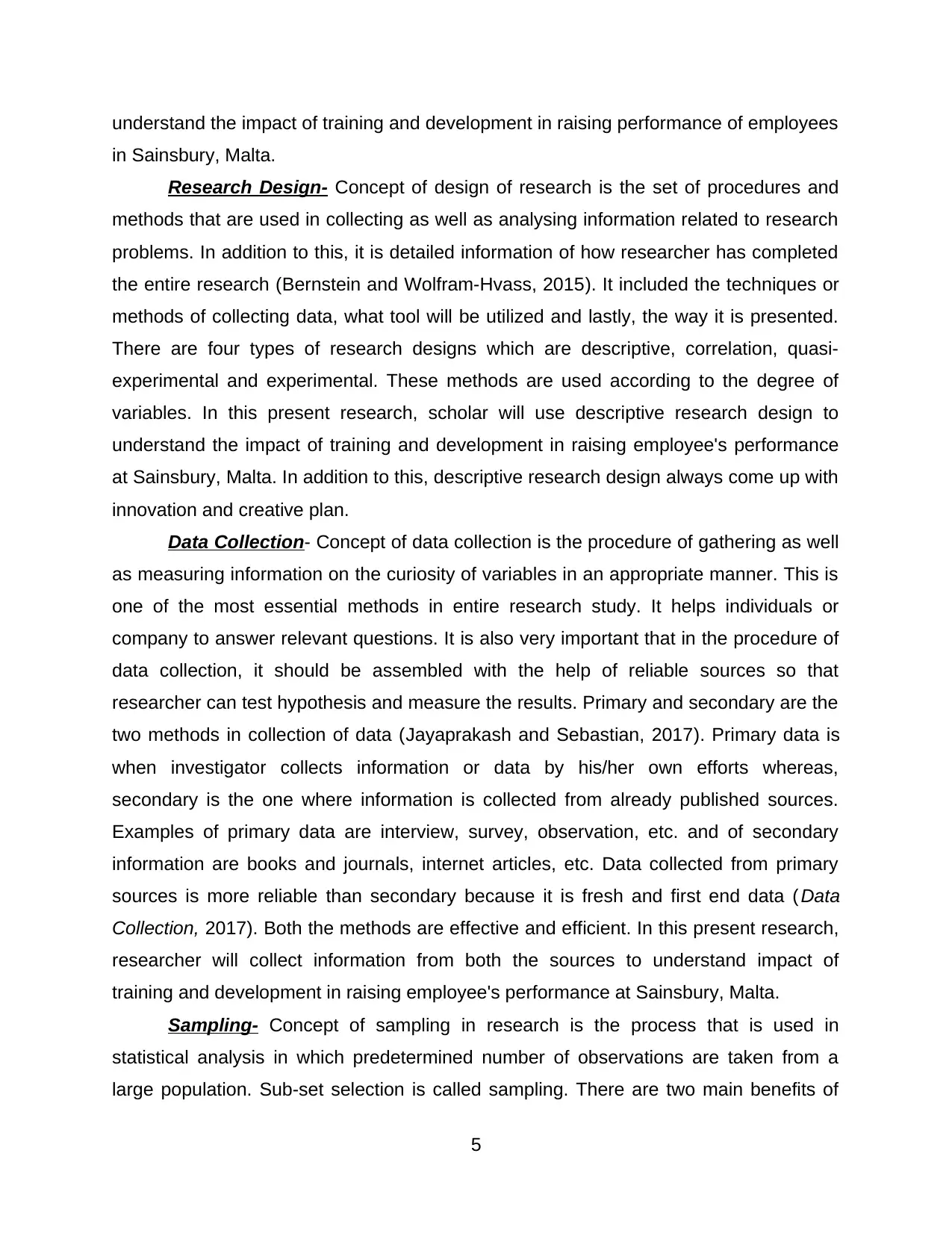
understand the impact of training and development in raising performance of employees
in Sainsbury, Malta.
Research Design- Concept of design of research is the set of procedures and
methods that are used in collecting as well as analysing information related to research
problems. In addition to this, it is detailed information of how researcher has completed
the entire research (Bernstein and Wolfram-Hvass, 2015). It included the techniques or
methods of collecting data, what tool will be utilized and lastly, the way it is presented.
There are four types of research designs which are descriptive, correlation, quasi-
experimental and experimental. These methods are used according to the degree of
variables. In this present research, scholar will use descriptive research design to
understand the impact of training and development in raising employee's performance
at Sainsbury, Malta. In addition to this, descriptive research design always come up with
innovation and creative plan.
Data Collection- Concept of data collection is the procedure of gathering as well
as measuring information on the curiosity of variables in an appropriate manner. This is
one of the most essential methods in entire research study. It helps individuals or
company to answer relevant questions. It is also very important that in the procedure of
data collection, it should be assembled with the help of reliable sources so that
researcher can test hypothesis and measure the results. Primary and secondary are the
two methods in collection of data (Jayaprakash and Sebastian, 2017). Primary data is
when investigator collects information or data by his/her own efforts whereas,
secondary is the one where information is collected from already published sources.
Examples of primary data are interview, survey, observation, etc. and of secondary
information are books and journals, internet articles, etc. Data collected from primary
sources is more reliable than secondary because it is fresh and first end data ( Data
Collection, 2017). Both the methods are effective and efficient. In this present research,
researcher will collect information from both the sources to understand impact of
training and development in raising employee's performance at Sainsbury, Malta.
Sampling- Concept of sampling in research is the process that is used in
statistical analysis in which predetermined number of observations are taken from a
large population. Sub-set selection is called sampling. There are two main benefits of
5
in Sainsbury, Malta.
Research Design- Concept of design of research is the set of procedures and
methods that are used in collecting as well as analysing information related to research
problems. In addition to this, it is detailed information of how researcher has completed
the entire research (Bernstein and Wolfram-Hvass, 2015). It included the techniques or
methods of collecting data, what tool will be utilized and lastly, the way it is presented.
There are four types of research designs which are descriptive, correlation, quasi-
experimental and experimental. These methods are used according to the degree of
variables. In this present research, scholar will use descriptive research design to
understand the impact of training and development in raising employee's performance
at Sainsbury, Malta. In addition to this, descriptive research design always come up with
innovation and creative plan.
Data Collection- Concept of data collection is the procedure of gathering as well
as measuring information on the curiosity of variables in an appropriate manner. This is
one of the most essential methods in entire research study. It helps individuals or
company to answer relevant questions. It is also very important that in the procedure of
data collection, it should be assembled with the help of reliable sources so that
researcher can test hypothesis and measure the results. Primary and secondary are the
two methods in collection of data (Jayaprakash and Sebastian, 2017). Primary data is
when investigator collects information or data by his/her own efforts whereas,
secondary is the one where information is collected from already published sources.
Examples of primary data are interview, survey, observation, etc. and of secondary
information are books and journals, internet articles, etc. Data collected from primary
sources is more reliable than secondary because it is fresh and first end data ( Data
Collection, 2017). Both the methods are effective and efficient. In this present research,
researcher will collect information from both the sources to understand impact of
training and development in raising employee's performance at Sainsbury, Malta.
Sampling- Concept of sampling in research is the process that is used in
statistical analysis in which predetermined number of observations are taken from a
large population. Sub-set selection is called sampling. There are two main benefits of
5
Paraphrase This Document
Need a fresh take? Get an instant paraphrase of this document with our AI Paraphraser
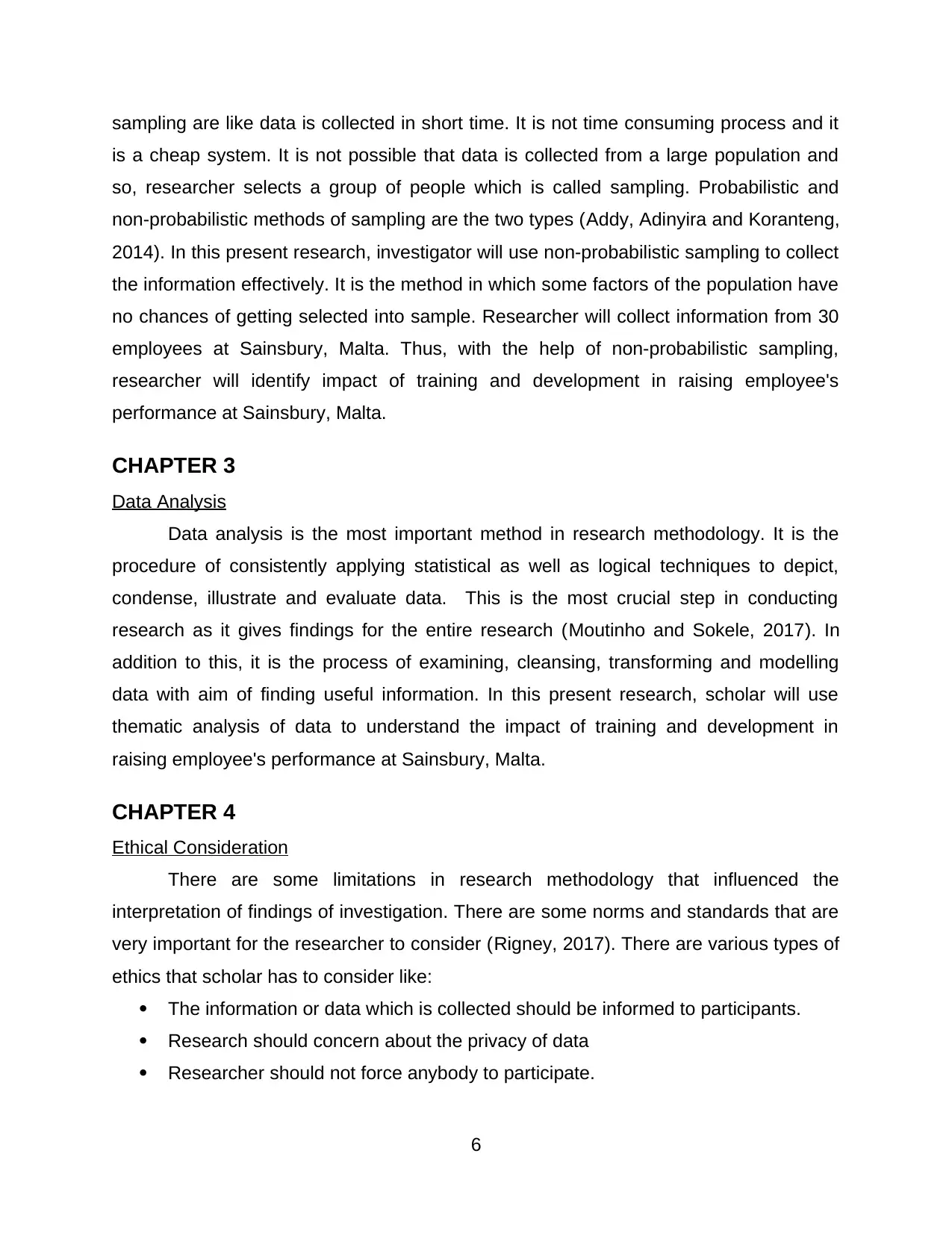
sampling are like data is collected in short time. It is not time consuming process and it
is a cheap system. It is not possible that data is collected from a large population and
so, researcher selects a group of people which is called sampling. Probabilistic and
non-probabilistic methods of sampling are the two types (Addy, Adinyira and Koranteng,
2014). In this present research, investigator will use non-probabilistic sampling to collect
the information effectively. It is the method in which some factors of the population have
no chances of getting selected into sample. Researcher will collect information from 30
employees at Sainsbury, Malta. Thus, with the help of non-probabilistic sampling,
researcher will identify impact of training and development in raising employee's
performance at Sainsbury, Malta.
CHAPTER 3
Data Analysis
Data analysis is the most important method in research methodology. It is the
procedure of consistently applying statistical as well as logical techniques to depict,
condense, illustrate and evaluate data. This is the most crucial step in conducting
research as it gives findings for the entire research (Moutinho and Sokele, 2017). In
addition to this, it is the process of examining, cleansing, transforming and modelling
data with aim of finding useful information. In this present research, scholar will use
thematic analysis of data to understand the impact of training and development in
raising employee's performance at Sainsbury, Malta.
CHAPTER 4
Ethical Consideration
There are some limitations in research methodology that influenced the
interpretation of findings of investigation. There are some norms and standards that are
very important for the researcher to consider (Rigney, 2017). There are various types of
ethics that scholar has to consider like:
The information or data which is collected should be informed to participants.
Research should concern about the privacy of data
Researcher should not force anybody to participate.
6
is a cheap system. It is not possible that data is collected from a large population and
so, researcher selects a group of people which is called sampling. Probabilistic and
non-probabilistic methods of sampling are the two types (Addy, Adinyira and Koranteng,
2014). In this present research, investigator will use non-probabilistic sampling to collect
the information effectively. It is the method in which some factors of the population have
no chances of getting selected into sample. Researcher will collect information from 30
employees at Sainsbury, Malta. Thus, with the help of non-probabilistic sampling,
researcher will identify impact of training and development in raising employee's
performance at Sainsbury, Malta.
CHAPTER 3
Data Analysis
Data analysis is the most important method in research methodology. It is the
procedure of consistently applying statistical as well as logical techniques to depict,
condense, illustrate and evaluate data. This is the most crucial step in conducting
research as it gives findings for the entire research (Moutinho and Sokele, 2017). In
addition to this, it is the process of examining, cleansing, transforming and modelling
data with aim of finding useful information. In this present research, scholar will use
thematic analysis of data to understand the impact of training and development in
raising employee's performance at Sainsbury, Malta.
CHAPTER 4
Ethical Consideration
There are some limitations in research methodology that influenced the
interpretation of findings of investigation. There are some norms and standards that are
very important for the researcher to consider (Rigney, 2017). There are various types of
ethics that scholar has to consider like:
The information or data which is collected should be informed to participants.
Research should concern about the privacy of data
Researcher should not force anybody to participate.
6
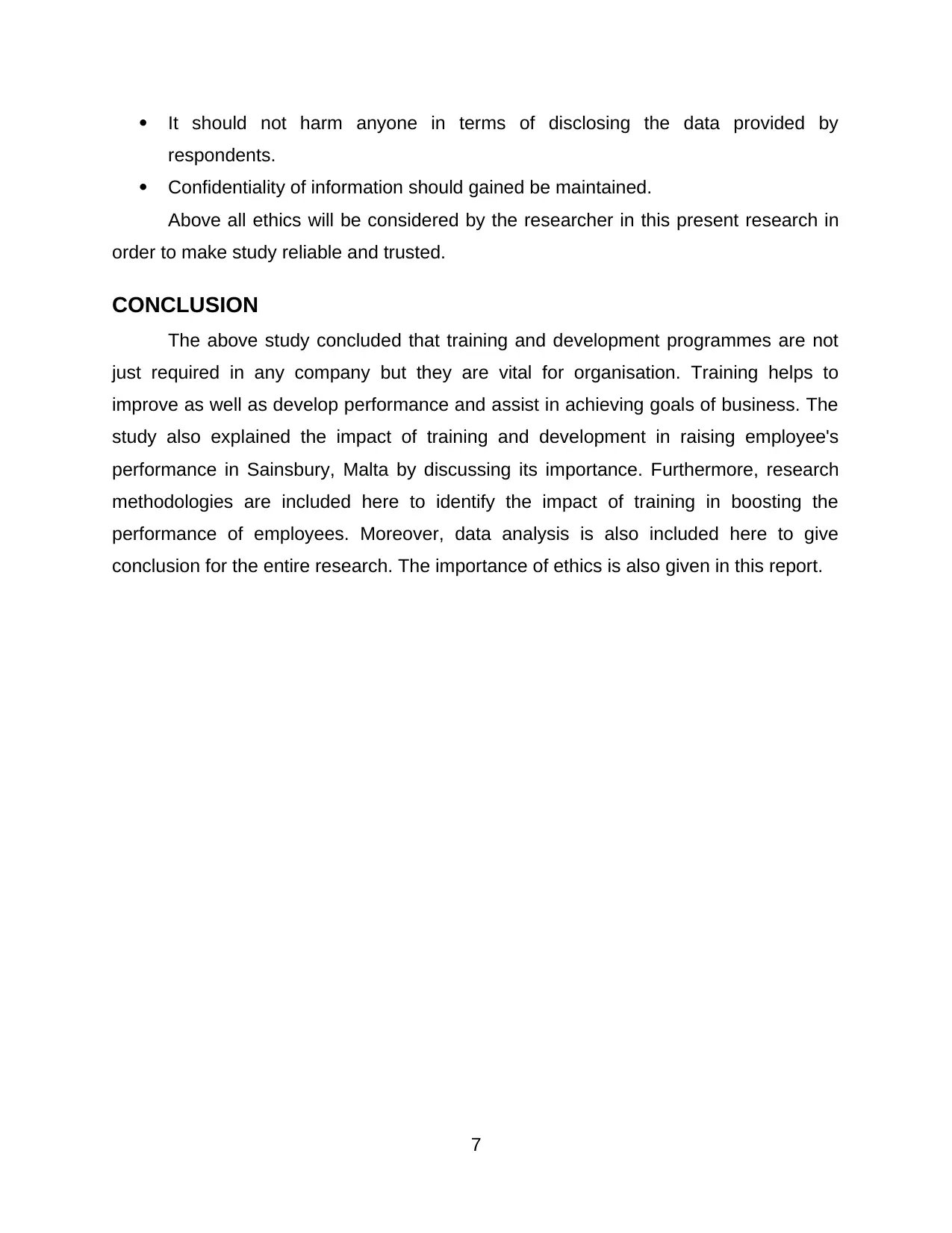
It should not harm anyone in terms of disclosing the data provided by
respondents.
Confidentiality of information should gained be maintained.
Above all ethics will be considered by the researcher in this present research in
order to make study reliable and trusted.
CONCLUSION
The above study concluded that training and development programmes are not
just required in any company but they are vital for organisation. Training helps to
improve as well as develop performance and assist in achieving goals of business. The
study also explained the impact of training and development in raising employee's
performance in Sainsbury, Malta by discussing its importance. Furthermore, research
methodologies are included here to identify the impact of training in boosting the
performance of employees. Moreover, data analysis is also included here to give
conclusion for the entire research. The importance of ethics is also given in this report.
7
respondents.
Confidentiality of information should gained be maintained.
Above all ethics will be considered by the researcher in this present research in
order to make study reliable and trusted.
CONCLUSION
The above study concluded that training and development programmes are not
just required in any company but they are vital for organisation. Training helps to
improve as well as develop performance and assist in achieving goals of business. The
study also explained the impact of training and development in raising employee's
performance in Sainsbury, Malta by discussing its importance. Furthermore, research
methodologies are included here to identify the impact of training in boosting the
performance of employees. Moreover, data analysis is also included here to give
conclusion for the entire research. The importance of ethics is also given in this report.
7
⊘ This is a preview!⊘
Do you want full access?
Subscribe today to unlock all pages.

Trusted by 1+ million students worldwide
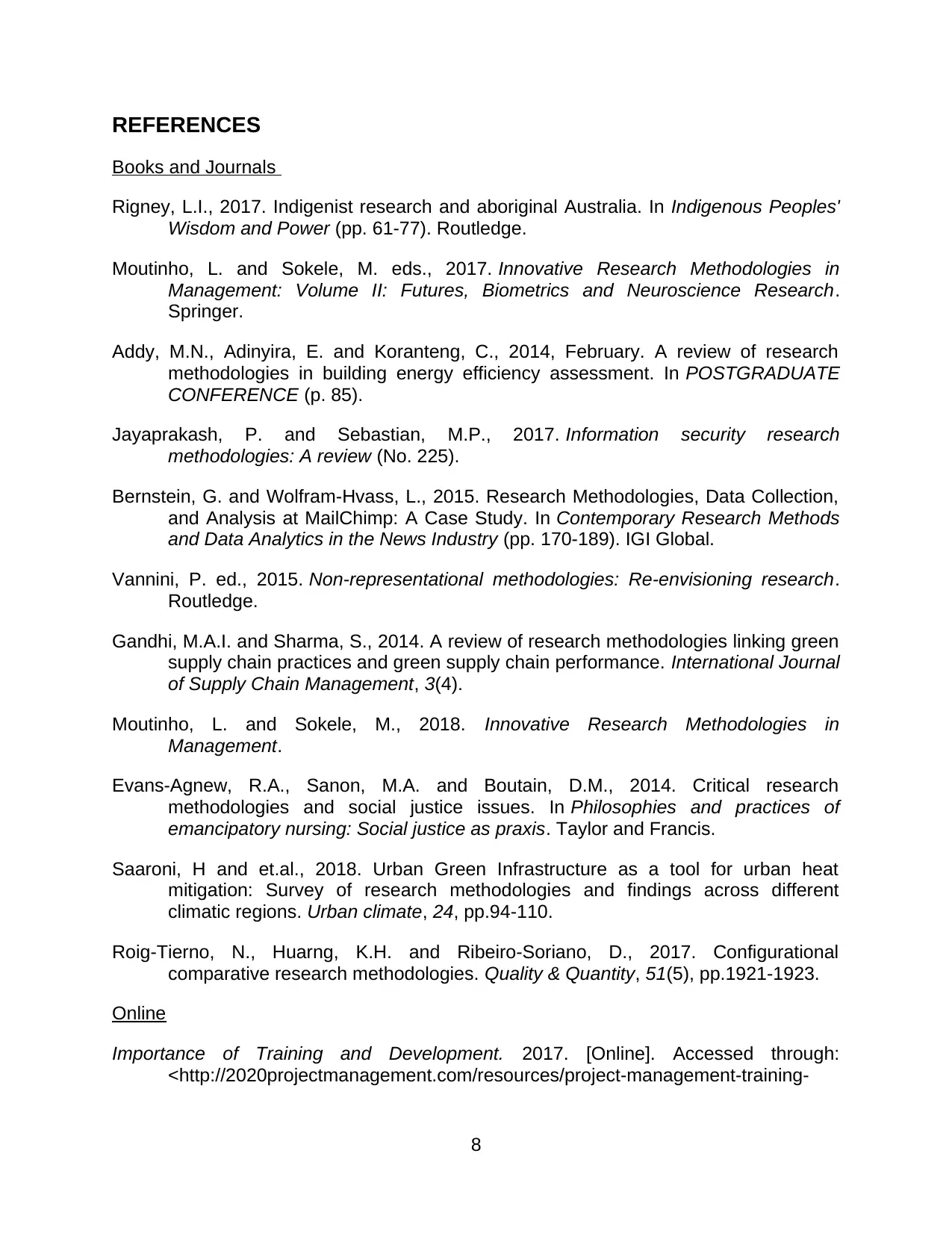
REFERENCES
Books and Journals
Rigney, L.I., 2017. Indigenist research and aboriginal Australia. In Indigenous Peoples'
Wisdom and Power (pp. 61-77). Routledge.
Moutinho, L. and Sokele, M. eds., 2017. Innovative Research Methodologies in
Management: Volume II: Futures, Biometrics and Neuroscience Research.
Springer.
Addy, M.N., Adinyira, E. and Koranteng, C., 2014, February. A review of research
methodologies in building energy efficiency assessment. In POSTGRADUATE
CONFERENCE (p. 85).
Jayaprakash, P. and Sebastian, M.P., 2017. Information security research
methodologies: A review (No. 225).
Bernstein, G. and Wolfram-Hvass, L., 2015. Research Methodologies, Data Collection,
and Analysis at MailChimp: A Case Study. In Contemporary Research Methods
and Data Analytics in the News Industry (pp. 170-189). IGI Global.
Vannini, P. ed., 2015. Non-representational methodologies: Re-envisioning research.
Routledge.
Gandhi, M.A.I. and Sharma, S., 2014. A review of research methodologies linking green
supply chain practices and green supply chain performance. International Journal
of Supply Chain Management, 3(4).
Moutinho, L. and Sokele, M., 2018. Innovative Research Methodologies in
Management.
Evans-Agnew, R.A., Sanon, M.A. and Boutain, D.M., 2014. Critical research
methodologies and social justice issues. In Philosophies and practices of
emancipatory nursing: Social justice as praxis. Taylor and Francis.
Saaroni, H and et.al., 2018. Urban Green Infrastructure as a tool for urban heat
mitigation: Survey of research methodologies and findings across different
climatic regions. Urban climate, 24, pp.94-110.
Roig-Tierno, N., Huarng, K.H. and Ribeiro-Soriano, D., 2017. Configurational
comparative research methodologies. Quality & Quantity, 51(5), pp.1921-1923.
Online
Importance of Training and Development. 2017. [Online]. Accessed through:
<http://2020projectmanagement.com/resources/project-management-training-
8
Books and Journals
Rigney, L.I., 2017. Indigenist research and aboriginal Australia. In Indigenous Peoples'
Wisdom and Power (pp. 61-77). Routledge.
Moutinho, L. and Sokele, M. eds., 2017. Innovative Research Methodologies in
Management: Volume II: Futures, Biometrics and Neuroscience Research.
Springer.
Addy, M.N., Adinyira, E. and Koranteng, C., 2014, February. A review of research
methodologies in building energy efficiency assessment. In POSTGRADUATE
CONFERENCE (p. 85).
Jayaprakash, P. and Sebastian, M.P., 2017. Information security research
methodologies: A review (No. 225).
Bernstein, G. and Wolfram-Hvass, L., 2015. Research Methodologies, Data Collection,
and Analysis at MailChimp: A Case Study. In Contemporary Research Methods
and Data Analytics in the News Industry (pp. 170-189). IGI Global.
Vannini, P. ed., 2015. Non-representational methodologies: Re-envisioning research.
Routledge.
Gandhi, M.A.I. and Sharma, S., 2014. A review of research methodologies linking green
supply chain practices and green supply chain performance. International Journal
of Supply Chain Management, 3(4).
Moutinho, L. and Sokele, M., 2018. Innovative Research Methodologies in
Management.
Evans-Agnew, R.A., Sanon, M.A. and Boutain, D.M., 2014. Critical research
methodologies and social justice issues. In Philosophies and practices of
emancipatory nursing: Social justice as praxis. Taylor and Francis.
Saaroni, H and et.al., 2018. Urban Green Infrastructure as a tool for urban heat
mitigation: Survey of research methodologies and findings across different
climatic regions. Urban climate, 24, pp.94-110.
Roig-Tierno, N., Huarng, K.H. and Ribeiro-Soriano, D., 2017. Configurational
comparative research methodologies. Quality & Quantity, 51(5), pp.1921-1923.
Online
Importance of Training and Development. 2017. [Online]. Accessed through:
<http://2020projectmanagement.com/resources/project-management-training-
8
Paraphrase This Document
Need a fresh take? Get an instant paraphrase of this document with our AI Paraphraser

and-qualifications/the-importance-of-training-and-development-in-the-
workplace>.
Data Collection. 2017. [Online]. Accessed through:
<https://www.toppr.com/bytes/collection-of-data/>.
9
workplace>.
Data Collection. 2017. [Online]. Accessed through:
<https://www.toppr.com/bytes/collection-of-data/>.
9
1 out of 11
Related Documents
Your All-in-One AI-Powered Toolkit for Academic Success.
+13062052269
info@desklib.com
Available 24*7 on WhatsApp / Email
![[object Object]](/_next/static/media/star-bottom.7253800d.svg)
Unlock your academic potential
Copyright © 2020–2025 A2Z Services. All Rights Reserved. Developed and managed by ZUCOL.





